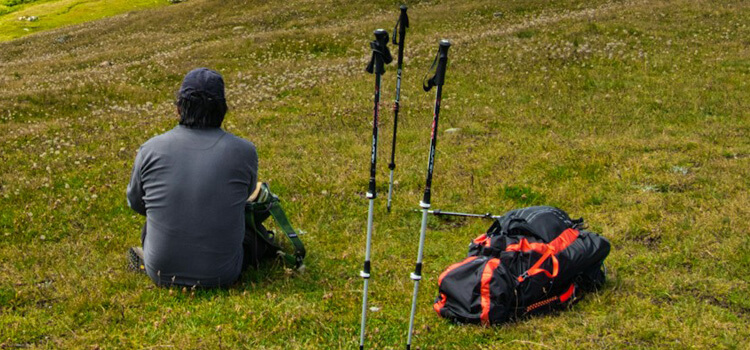As an Amazon Associate, I earn from qualifying purchases.

A hiking pole can be attached to a backpack through elastic loops or specifically included pole attachments. However, the pole should be secured firmly with straps to avoid wobbling. Hikers and many outdoor enthusiasts constantly contend with the burden of their gear. Understanding how to attach hiking pole to backpack is crucial in moving your gear efficiently but also in securing it for easy access to diverse terrains. For this reason, modern backpacks are usually integrated with features such as elastic loops, gear loops, or Velcro straps that ensure the pole is attached firmly. Mastering this skill means your hands are free and your gear is securely attached.
Types Of Hiking Pole Attachments
None of us want to hang hiking poles in our hands when we cannot use them properly. Therefore, it is essential to attach all our poles together with the backpack so that our hands are free to focus on balancing while climbing, or hold the camera while taking memorable pictures. Below I have mentioned several ways you can lock your poles depending on your backpack or the poles.
Integrated Attachment Systems
Most modern packs come with some built-in features to attach hiking poles. The following integrated systems are available to attach your poles:
- Elastic loops and toggle: Slide your poles through the loop, and secure by clipping the toggle;
- Dedicated pole pockets: Slide the poles in the compartment and cinch shut;
- Adjustable side straps: Clip carriers to the side and cinch in;
External Attachment Options
Without integrated features on your backpack, you have to choose the external types to connect:
- Velcro straps: Wrap around the poles and backpack to hold in place;
- Elastic cords with cord locks: Thread through pole straps and pull tight;
- Carabiner clips: Attach to any loop or strap on your bag;
Essential Tools And Materials
Essential tools and materials make attaching your hiking poles to your backpack easy. When you have the right gear, taking poles becomes quick, easy, and secure. Make your hiking adventure hassle-free.
Backpack With Attachment Points
A hiking bag is supposed to have loops or known as lash points built-in. Most modern-day hiking backpacks have special slots or elastic tool loops for hiking poles. Make sure your loops are strong enough to easily carry the rods.
Shock Cord Or Bungee Cord
The primary tool for attaching the poles will be a length of shock cord or bungee cord. This cord is elastic and unbreakable, so your equipment will be as firm as possible. Make sure you have enough cord to wrap your poles and backpack.
- Cut a piece of 24 inch long cord;
- Burn the edges with a lighter to avoid fretting;
Carabiners Or Clips
A carabiner or small clip will be the last part of the pole strapping. This will add an additional level of security to the poles. They can be easily attached on the backpack and the poles for lessening the possibility of your hiking poles falling off during your way. Get all these materials before you start attaching your poles to your backpack.
| Type of Carabiner | Use-case |
| Non-locking | Quick attachment for lighter poles |
| Locking | Extra security for rough terrains |
Step-by-step Guide
The following, easy steps to latch your hiking poles onto your backpack. With it, your hands can be free and ready to hit the trail faster.
Identifying Attachment Points On The Backpack
Now that you have your backpack and poles ready, let’s identify the attachment points. First, you need a gear loop or a lash tab on the backpack. These may be found on the pack’s back or sides.
- It is small, often a loop with a strap;
- Some packs have bungee cords or elastic bands;

Securing The Hiking Poles Using Shock Cord
You need a shock cord, which is flexible enough for this load. Here’s how:
- You wrap it in the gear loop;
- Tighten it by wrapping around the shaft of the pole;
- Connect with a knot and then ensure that the pole tip points down;
Adding Extra Security With Carabiners
It will be fastened to the gear loop. Connect with the support or hole of the pole, ensuring that the pole does not shake from side to side.
Tips For Efficiency And Safety
Consider the hiking poles as your backup when you are hiking. It shouldn’t be too hard for you to connect it in a non-risky position on to your back pack.
Ensuring Proper Weight Distribution
Equally important is the even distribution of weight. It will save you from minor injuries and make Hiking more enjoyable. To properly balance the poles:
- Lay the poles horizontally on the bottom of the pack;
- Secure them with side compression straps;
Regularly Checking The Attachment
Hiking poles can become loose. So, give a poles a quick check now and then:
- On prior to start, check that poles are well attached;
- During breaks check if there was any slipping or looseness;
- After the change of the terrain, re-check the attachment;
Adjusting For Different Terrains
Different terrains need different setups. Be great to adjust:
- Flat terrain: Poles can stay attached longer;
- Uphill climbs: If you need to help with the ascent, detach the poles quickly;
- Downhill paths: You can keep the poles in your hands for the ascent;
Alternative Methods
To Secure Hiking Poles Exploring the great tool while using the hiking poles will increase your balance and stamina. But how to be with poles when they are not in use? Let’s move to the creative part which will help to keep poles attached to the backpack.
Using Trekking Pole Loops
The rain of the backpack in recent years comes with specialized loops designed for trekking poles to use them:
- Find the hoop for the poles, somewhere on the base of the pack;
- Slide the palm strings of the poles through them;
- Secure the poles by cord, or lock them with clasp;
- It is crucial to tighten the cord to ensure no slippage;

Diy Backpack Modifications
If the pack does not offer pole locking loops, modification will be easy. Here is how:
- Attach elastic cords with toggles to the pack;
- Wrap around the poles;
- Attach carabiners to clip coasters to gear loops;
- If you have a tailoring skill, sew some loops on the pack’s fabric;
Conclusion
Tying hiking pole to your backpack attach doesn’t have to be a headache for you. Once you learn the steps and practice them, it becomes simple to do. Make sure you can access the poles quickly and that they do not work loose while on transit.
Related Articles:
- How to Pack a Hiking Backpack Diagram
- Best Hiking Backpacks for Tall Guys
- Best Camping Chairs for Bad Back
FAQs
To tie a pole to a backpack, secure it alongside your pack using compression straps. Make sure the weight of the pole is spread evenly so you won’t struggle with balance. To attach the pole, hold its bottom first. Then fasten the top part with the straps, and make sure they are secure. Finally, tighten the straps again, this time closer to your body, to minimize the poles’ movement while hiking.
Find side compression straps or backpack’s external gear loop . Slide the trekking poles into the loops so that their tips point downwards. Then, use the straps; or loops to hold poles in place. Make them tight around the poles’ shafts for better balance. If you have two poles, cross them.
While hiking poles, consider using baskets if you’re hiking in the snow or mud. Use rubber tips when walking on paved roads or trails to protect surfaces and tips.
You can attach hiking poles to a Gregory backpack by the tool attachments it features. You can also loop the poles in the side compression straps.
As an Amazon Associate, I earn from qualifying purchases.
Leave a Reply